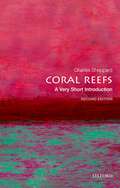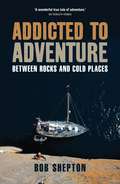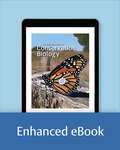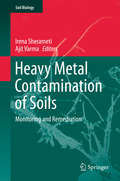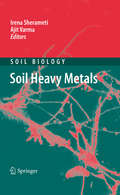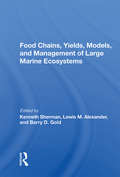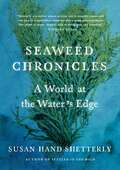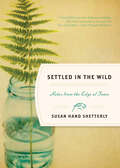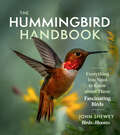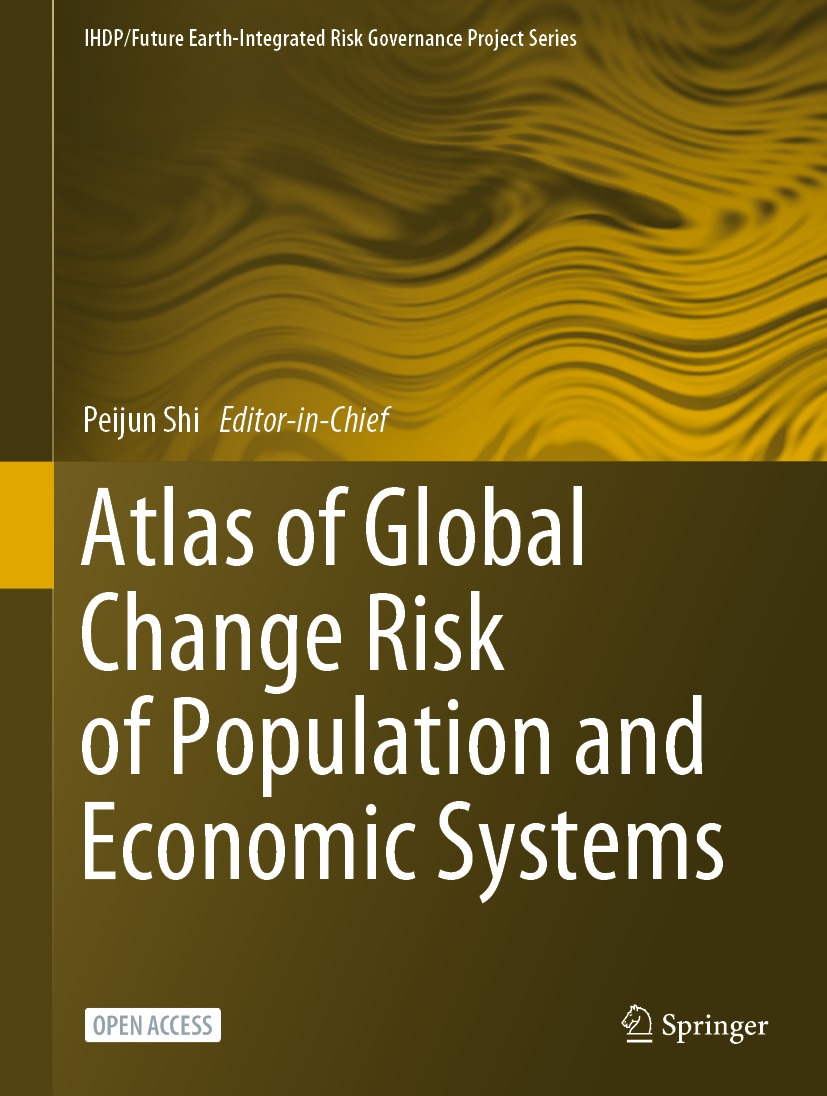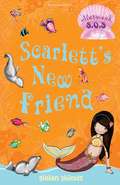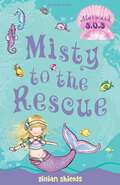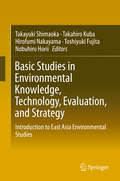- Table View
- List View
Coral Reefs: A Very Short Introduction (Very Short Introductions #4)
by Charles SheppardVery Short Introductions: Brilliant, Sharp, Inspiring Coral reefs are among the most beautiful, and most diverse, of ecosystems. Early seafarers were wary of them, naturalists were confused by them, yet many coastal people benefited greatly from these mysterious rocky structures that grew up to the surface of the sea. They have been rich in their supply of food, and they provided a breakwater from storms and high waves to countless coastal communities that developed from their protection. Their scale is enormous and their value high. Found in countless locations around the world, from the Indo-Pacific coral reef province to the Caribbean and Australia, they support both marine and human life. But today coral reefs are in trouble, with many dying or suffering from over-exploitation, pollution, and the warming and acidification of the oceans. Understanding reefs, their conservation and management, is vital, and so is conveying this to authority if we are to preserve these remarkable ecosystems. In this Very Short Introduction Charles Sheppard describes the complex structure and interdependencies of a reef, how reefs have evolved, the diversity of marine life that they support, and their importance to the human population who live beside them. This new edition describes the latest research on the complex symbioses of coral animals with microorganisms. It also highlights the scale of the challenge facing our reefs today, following recent ocean heatwaves - part of wider climate disruption - that killed half the world's reefs, and considers what can be done to preserve these essential and vibrant ecosystems. ABOUT THE SERIES: The Very Short Introductions series from Oxford University Press contains hundreds of titles in almost every subject area. These pocket-sized books are the perfect way to get ahead in a new subject quickly. Our expert authors combine facts, analysis, perspective, new ideas, and enthusiasm to make interesting and challenging topics highly readable.
Coral Reefs: A Very Short Introduction (Very Short Introductions)
by Charles SheppardVery Short Introductions: Brilliant, Sharp, Inspiring Coral reefs are among the most beautiful, and most diverse, of ecosystems. Early seafarers were wary of them, naturalists were confused by them, yet many coastal people benefited greatly from these mysterious rocky structures that grew up to the surface of the sea. They have been rich in their supply of food, and they provided a breakwater from storms and high waves to countless coastal communities that developed from their protection. Their scale is enormous and their value high. Found in countless locations around the world, from the Indo-Pacific coral reef province to the Caribbean and Australia, they support both marine and human life. But today coral reefs are in trouble, with many dying or suffering from over-exploitation, pollution, and the warming and acidification of the oceans. Understanding reefs, their conservation and management, is vital, and so is conveying this to authority if we are to preserve these remarkable ecosystems. In this Very Short Introduction Charles Sheppard describes the complex structure and interdependencies of a reef, how reefs have evolved, the diversity of marine life that they support, and their importance to the human population who live beside them. This new edition describes the latest research on the complex symbioses of coral animals with microorganisms. It also highlights the scale of the challenge facing our reefs today, following recent ocean heatwaves - part of wider climate disruption - that killed half the world's reefs, and considers what can be done to preserve these essential and vibrant ecosystems. ABOUT THE SERIES: The Very Short Introductions series from Oxford University Press contains hundreds of titles in almost every subject area. These pocket-sized books are the perfect way to get ahead in a new subject quickly. Our expert authors combine facts, analysis, perspective, new ideas, and enthusiasm to make interesting and challenging topics highly readable.
Addicted to Adventure: Between Rocks and Cold Places
by Bob SheptonBob Shepton is an ordained minister in the Church of England in his late 70s, but spends most of his time sailing into the Arctic and making first ascents of inaccessible mountains. No tea parties for this vicar.Opening with the disastrous fire that destroyed his yacht whilst he was ice-bound in Greenland, the book travels back to his childhood growing up on the rubber plantation his father managed in Malaysia, moving back to England after his father was shot by the Japanese during the war, boarding school, the Royal Marines, and the church. We then follow Bob as he sails around the world with a group of schoolboys, is dismasted off the Falklands, trapped in ice, and climbs mountains accessible only from iceberg-strewn water and with only sketchy maps available. Bob Shepton, winner of the 2013 Yachtsman of the Year Award, is an old-school adventurer, and this compelling book is in the spirit of sailing mountaineer HW Tilman, explorer Ranulph Fiennes, climber Chris Bonington and yachtsman Robin Knox-Johnston, all of whom have been either friends of Bob's or an inspiration for his own exploits. Derring do in a dog collar!Ranulph Fiennes: 'A wonderful true tale of adventure.'Bear Grylls: 'You are going to enjoy this...as a Commando, Bob is clearly made of the right stuff!'
An Introduction to Conservation Biology
by Anna SherAn Introduction to Conservation Biology is the only text designed for both aspiring conservation biologists and non-majors who are interested in this topical field, providing up-to-date perspectives on high-profile issues such as sustainable development, global warming, and strategies to save species on the verge of extinction. The book focuses successively on biological diversity and its value; threats to biological diversity; conservation at the population and species levels; protecting, managing and restoring ecosystems; and sustainable development. Each chapter is beautifully illustrated in full color with diverse examples from the current literature. Chapters begin with guiding conservation biology principles and end with study aids such as summaries, an annotated list of suggested readings, and discussion questions. Throughout, the authors maintain a focus on the active role that scientists, local people, conservation organizations, government, and the general public play in protecting biodiversity, even while providing for human needs.
An Introduction to Conservation Biology
by Anna SherAn Introduction to Conservation Biology is the only text designed for both aspiring conservation biologists and non-majors who are interested in this topical field, providing up-to-date perspectives on high-profile issues such as sustainable development, global warming, and strategies to save species on the verge of extinction. The book focuses successively on biological diversity and its value; threats to biological diversity; conservation at the population and species levels; protecting, managing and restoring ecosystems; and sustainable development. Each chapter is beautifully illustrated in full color with diverse examples from the current literature. Chapters begin with guiding conservation biology principles and end with study aids such as summaries, an annotated list of suggested readings, and discussion questions. Throughout, the authors maintain a focus on the active role that scientists, local people, conservation organizations, government, and the general public play in protecting biodiversity, even while providing for human needs.
Heavy Metal Contamination of Soils: Monitoring and Remediation (Soil Biology #44)
by Irena Sherameti Ajit VarmaFollowing a description of the various sources and factors influencing the contents of heavy metal pollution in post-catastrophic and agricultural soils, subsequent chapters examine soil enzymes and eggs as bio-monitors, lead adsorption, the effects of arsenic on microbial diversity, and the effects of Mediterranean grasslands on abandoned mines. A third section focuses on the adaptation strategies used by plants and bacteria, such as Pinus sylvestris in industrial areas, and the rhizosphere in contaminated tropical soils and soil treated with sewage sludge. Further topics addressed include strategies of bioremediation, e.g. using transgenic plants as tools for soil remediation.This new volume on heavy metals in soil will be of interest to researchers and scholars in microbial and plant biotechnology, agriculture, the environmental sciences and soil ecology.
Soil Heavy Metals: Monitoring And Remediation (Soil Biology #19)
by Irena Sherameti Ajit VarmaHuman activities have dramatically changed the composition and organisation of soils. Industrial and urban wastes, agricultural application and also mining activities resulted in an increased concentration of heavy metals in soils. How plants and soil microorganisms cope with this situation and the sophisticated techniques developed for survival in contaminated soils is discussed in this volume. The topics presented include: the general role of heavy metals in biological soil systems; the relation of inorganic and organic pollutions; heavy metal, salt tolerance and combined effects with salinity; effects on abuscular mycorrhizal and on saprophytic soil fungi; heavy metal resistance by streptomycetes; trace element determination of environmental samples; the use of microbiological communities as indicators; phytostabilization of lead polluted sites by native plants; effects of soil earthworms on removal of heavy metals and the remediation of heavy metal contaminated tropical land.
Charging Ahead
by Joe ShermanCharging Ahead is a classic tale of perseverance against daunting odds in the pursuit of a personal dream--and an environmental revolution. You'd have to be a fool to market a consumer electric car, let alone challenge the big three auto makers with a little start up company. But MIT graduate James Worden, with his girlfriend and a handful of audacious engineers, did both and he's well on his way to success. In this marvelous narrative, business writer Joe Sherman vividly describes how Worden and his team built the world's most advanced EV (electric vehicle), the Sunrise. Combining insightful biography with the best of science and business writing, Sherman captures not only Worden's own gripping story, but also the technical challenge of designing an electric car in an age of anxiety over the environment. He depicts Worden's fascination with EVs from childhood (he built his award winning first electric car in high school), tracing it through his monomaniacal career at MIT, where he organized a student team that built EVs for races worldwide, to the founding of Solectria, a company committed to building a consumer electric car. Sherman shows how, despite all the obstacles, Solectria eventually lined up such strategic partners as the Pentagon on its way to producing the Sunrise a lightweight, all-composite, high tech commuter car. The Sunrise would triumph over rivals from the Big Three in the 7th American Tour de Sol, and later travel from Boston to New York on a single battery charge. Charging Ahead is an engaging story of James Worden's struggle to succeed with idealism, energy, and technological superiority against seemingly impossible odds.
Food Chains, Yields, Models, And Management Of Large Marine Ecosoystems
by Kenneth ShermanDraws on case studies from tropical, temperate, and Arctic waters around the world, comparing multispecies biomass yield models for various large marine ecosystems. Emphasis is given to adaptive management as a strategy for maximizing the sustainability and productivity of living marine resources.
Food Chains, Yields, Models, And Management Of Large Marine Ecosoystems
by Kenneth ShermanDraws on case studies from tropical, temperate, and Arctic waters around the world, comparing multispecies biomass yield models for various large marine ecosystems. Emphasis is given to adaptive management as a strategy for maximizing the sustainability and productivity of living marine resources.
Opening Windows: Embracing New Perspectives and Practices in Natural Resource Social Sciences (Society and Natural Resources Book Series)
by Kate Sherren Gladman Thondhlana Douglas Jackson-SmithThe third decennial review from the International Association for Society and Natural Resources, Opening Windowssimultaneously examines the breadth and societal relevance of Society and Natural Resources (SNR) knowledge, explores emergent issues and new directions in SNR scholarship, and captures the increasing diversity of SNR research. Authors from various backgrounds—career stage, gender and sexuality, race/ethnicity, and global region—provide a fresh, nuanced, and critical look at the field from both researchers’ and practitioners’ perspectives. This reflexive book is organized around four key themes: diversity and justice, governance and power, engagement and elicitation, and relationships and place. This is not a complacent volume—chapters point to gaps in conventional scholarship and to how much work remains to be done. Power is a central focus, including the role of cultural and economic power in “participatory” approaches to natural resource management and the biases encoded into the very concepts that guide scholarly and practical work. The chapters include robust literature syntheses, conceptual models, and case studies that provide examples of best practices and recommend research directions to improve and transform natural resource social sciences. An unmistakable spirit of hope is exemplified by findings suggesting positive roles for research in the progress ahead. Bringing fresh perspectives on the assumptions and interests that underlie and entangle scholarship on natural resource decisionmaking and the justness of its outcomes, Opening Windows is significant for scholars, students, natural resource practitioners, managers and decision makers, and policy makers.
Seven Climbs: Finding the finest climb on each continent
by Charles Sherwood'Even the most casual reader among you will by now have worked out that the whole thing is little more than a delightful ruse for having a very good time.'Experienced climber Charles Sherwood is on a quest to find the best climb on each continent. He eschews the traditional Seven Summits, where height alone is the determining factor, and instead considers mountaineering challenge, natural beauty and historical context, aiming to capture the diverse character of each continent and the sheer variety of climbing in all its forms.The author's ambitious odyssey takes him to the Alps, the Himalaya, Yosemite, the Andes, Kenya, New Zealand and South Georgia. His goal is neither to seek glory nor to complete a box-ticking exercise, but simply to enjoy himself in the company of his fellow climbers, including Mark Seaton, Andy Kirkpatrick and Stephen Venables, and to appreciate the splendour of his surroundings. On classic routes like the North Face of the Eiger and the Nose on El Capitan, it is hard not to be swept away by Sherwood's unfaltering enthusiasm.Also featuring fascinating historical detail about each route, Seven Climbs is a compelling account of Sherwood's efforts to answer a much-debated question: which are the world’s greatest climbs?
The Ice House
by Monica SherwoodWith shades of When You Reach Me, The Thing About Jellyfish, and Bridge to Terabithia, and a big, timely climate hook at its core, here is a heartfelt middle grade debut about the inevitability of change that will resonate profoundly during these extraordinary times.Spring has arrived, and yet an unyielding winter freeze has left Louisa snowed into her apartment building for months with parents coping with extreme stress, a little brother struggling with cabin fever, and—awkwardly—her neighbor and former close friend, Luke. The new realities of this climate disaster have not only affected Louisa's family, but when Luke's dad has an ice-related accident and it's unclear if he'll recover, both families' lives are turned upside down.Desperate to find an escape from the grief plaguing their homes, Louisa and Luke build a massive snow fort in their yard. But their creation opens up an otherworldly window to what could lie ahead, and sets them on a mission: to restore the universe to its rightful order, so the ice will melt and life will return to "normal".With a deft combination of heartfelt prose and a touch of magic, Monica Sherwood's affecting debut novel is a relatable story of families grappling with—and emerging from—a different kind of quarantine.
Seaweed Chronicles: A World at the Water's Edge
by Susan Hand Shetterly&“You might not expect unfettered passion on the topic of seaweed, but Shetterly is such a great storyteller that you find yourself following along eagerly.&” —Mark Kurlansky &“Seaweed is ancient and basic, a testament to the tenacious beginnings of life on earth,&” writes Susan Hand Shetterly in this elegant, fascinating book. &“Why wouldn&’t seaweeds be a protean life source for the lives that have evolved since?&” On a planet facing environmental change and diminishing natural resources, seaweed is increasingly important as a source of food and as a fundamental part of our global ecosystem. In Seaweed Chronicles, Shetterly takes readers deep into the world of this essential organism by providing an immersive, often poetic look at life on the rugged shores of her beloved Gulf of Maine, where the growth and harvesting of seaweed is becoming a major industry. While examining the life cycle of seaweed and its place in the environment, she tells the stories of the men and women who farm and harvest it—and who are fighting to protect this critical species against forces both natural and man-made. Ideal for readers of such books as The Hidden Life of Trees and How to Read Water, Seaweed Chronicles is a deeply informative look at a little understood and too often unappreciated part of our habitat.
Settled in the Wild: Notes from the Edge of Town
by Susan Hand ShetterlyWhether we live in cities, suburbs, or villages, we are encroaching on nature, and it in one way or another perseveres. Naturalist Susan Shetterly looks at how animals, humans, and plants share the land—observing her own neighborhood in rural Maine. She tells tales of the locals (humans, yes, but also snowshoe hares, raccoons, bobcats, turtles, salmon, ravens, hummingbirds, cormorants, sandpipers, and spring peepers). She expertly shows us how they all make their way in an ever-changing habitat. In writing about a displaced garter snake, witnessing the paving of a beloved dirt road, trapping a cricket with her young son, rescuing a fledgling raven, or the town's joy at the return of the alewife migration, Shetterly issues warnings even as she pays tribute to the resilience that abounds. Like the works of Annie Dillard and Aldo Leopold, Settled in the Wild takes a magnifying glass to the wildness that surrounds us. With keen perception and wit, Shetterly offers us an education in nature, one that should inspire us to preserve it.
The Hummingbird Handbook: Everything You Need to Know about These Fascinating Birds
by John SheweyA must-read for gardeners and birders, The Hummingbird Handbook is a complete guide to attracting, understanding, and protecting hummingbirds.
Atlas of Global Change Risk of Population and Economic Systems (IHDP/Future Earth-Integrated Risk Governance Project Series)
by Peijun ShiThis book is open access and illustrates the spatial distribution of the global change risk of population and economic systems with the maps of environment, global climate change, global population and economic systems, and global change risk. The risks of global change are mapped at 0.25 degree grid unit. The risk results and their contribution rates of the world at national level are unprecedentedly derived and ranked. The book can be a good reference for researchers and students in the field of global climate change and natural disaster risk management, as well as risk managers and enterpriser to understand the global change risk of population and economic systems.
International Liability Regime for Biodiversity Damage: The Nagoya-Kuala Lumpur Supplementary Protocol (Routledge Research in International Environmental Law)
by Akiho ShibataThe Nagoya-Kuala Lumpur Supplementary Protocol on Liability and Redress to the Cartagena Protocol on Biosafety, adopted on 15 October 2010 in Nagoya, Japan, provides an international liability regime for biodiversity damage caused by living modified organisms (LMOs). Its adoption marks a significant development in the legal design for international environmental liability regimes, as it incorporates for the first time in global treaties an administrative approach to liability. This book examines the Supplementary Protocol from both practitioner and academic perspectives. In its three parts the book explores the historical development, legal significances, and future implementation of the core provisions of the Supplementary Protocol, focusing specifically on its incorporation of an administrative approach to liability for biodiversity damage and its relation to civil liability. Contributors to the volume include Co-Chairs of the negotiating group and the negotiators and advisors from some of the key negotiating Parties, offering valuable insights into the difficult-to-read provisions of the Supplementary Protocol. The book demonstrates the significant changes in the political configuration of environmental treaty negotiations which have come about in the twenty-first century, and argues that the liability approach of the Supplementary Protocol has important implications for future development of international liability regimes under international environmental law.
International Liability Regime for Biodiversity Damage: The Nagoya-Kuala Lumpur Supplementary Protocol (Routledge Research in International Environmental Law)
by Akiho ShibataThe Nagoya-Kuala Lumpur Supplementary Protocol on Liability and Redress to the Cartagena Protocol on Biosafety, adopted on 15 October 2010 in Nagoya, Japan, provides an international liability regime for biodiversity damage caused by living modified organisms (LMOs). Its adoption marks a significant development in the legal design for international environmental liability regimes, as it incorporates for the first time in global treaties an administrative approach to liability. This book examines the Supplementary Protocol from both practitioner and academic perspectives. In its three parts the book explores the historical development, legal significances, and future implementation of the core provisions of the Supplementary Protocol, focusing specifically on its incorporation of an administrative approach to liability for biodiversity damage and its relation to civil liability. Contributors to the volume include Co-Chairs of the negotiating group and the negotiators and advisors from some of the key negotiating Parties, offering valuable insights into the difficult-to-read provisions of the Supplementary Protocol. The book demonstrates the significant changes in the political configuration of environmental treaty negotiations which have come about in the twenty-first century, and argues that the liability approach of the Supplementary Protocol has important implications for future development of international liability regimes under international environmental law.
Scarlett's New Friend: Mermaid S.O.S.
by Gillian ShieldsScarlett and her fellow Sisters of the Sea are only a day away from Coral Kingdom and completing their mission! But the evil Mantora is still trying to stop them, this time littering a nearby beach with garbage. Scarlett's got to stop being bossy and learn to make friends to get the beach cleared in time.
Misty to the Rescue: Mermaid S.O.S. #1
by Gillian Shields Helen TurnerMeet Misty and the Mermaid Sisters of the Sea! Misty and her friends are on a very important mission: they must find the six Magic Crystals that give life and strength the Merfolk, and bring them back to Coral Kingdom. But a wicked mermaid named Mantora would like nothing better than to keep the Sisters of the Sea from completing their task. This time she's sent a powerful storm that's blown the mermaids off-course. Can Misty help her friends get back on track? Read all the adventures of the Mermaid Sisters!
Why Sharks Matter: A Deep Dive with the World's Most Misunderstood Predator
by David ShiffmanGet submerged in the amazing world of sharks! Your expert host, award-winning marine biologist Dr. David Shiffman, will show you how—and why—we should protect these mysterious, misunderstood guardians of the ocean.Sharks are some of the most fascinating, most ecologically important, most threatened, and most misunderstood animals on Earth. More often feared than revered, their role as predators of the deep have earned them a reputation as a major threat to humans. But the truth is that sharks are not a danger to us—they're in danger from us.In Why Sharks Matter, marine conservation biologist Dr. David Shiffman explains why it's crucial that we overcome our misconceptions and rise above cinematic jump scares to embrace sharks as the imperiled and elegant ocean guardians they really are. Sharing his own fascinating experiences working with sharks, Shiffman tells us• why healthy shark populations are a must for supporting ocean ecosystems—and the coastal economies that depend on them • why we're in danger of losing many shark species forever• what scientists, conservationists, and readers can do to help save these iconic predators• why so much of what you've heard about sharks and how to save them is wrong Exploring the core tenets of shark conservation science and policy, Shiffman synthesizes decades of scientific research and policymaking, weaving it into a narrative full of humor and adventure. Touching on everything from Shark Week to shark fin soup, overfishing to marine sanctuaries, Shiffman reveals why sharks are in trouble, why we should care, and how we can save them. Perfect for shark enthusiasts, Why Sharks Matter is an approachable, informative guide to the world of shark conservation and the passionate, fascinating, brilliant people who work to understand and protect our oceans. This fun read will have you looking at sharks with a fresh perspective and an understanding that the survival of sharks is crucial to the survival of another apex predator—ourselves.
Why Sharks Matter: A Deep Dive with the World's Most Misunderstood Predator
by David ShiffmanGet submerged in the amazing world of sharks! Your expert host, award-winning marine biologist Dr. David Shiffman, will show you how—and why—we should protect these mysterious, misunderstood guardians of the ocean.Sharks are some of the most fascinating, most ecologically important, most threatened, and most misunderstood animals on Earth. More often feared than revered, their role as predators of the deep have earned them a reputation as a major threat to humans. But the truth is that sharks are not a danger to us—they're in danger from us.In Why Sharks Matter, marine conservation biologist Dr. David Shiffman explains why it's crucial that we overcome our misconceptions and rise above cinematic jump scares to embrace sharks as the imperiled and elegant ocean guardians they really are. Sharing his own fascinating experiences working with sharks, Shiffman tells us• why healthy shark populations are a must for supporting ocean ecosystems—and the coastal economies that depend on them • why we're in danger of losing many shark species forever• what scientists, conservationists, and readers can do to help save these iconic predators• why so much of what you've heard about sharks and how to save them is wrong Exploring the core tenets of shark conservation science and policy, Shiffman synthesizes decades of scientific research and policymaking, weaving it into a narrative full of humor and adventure. Touching on everything from Shark Week to shark fin soup, overfishing to marine sanctuaries, Shiffman reveals why sharks are in trouble, why we should care, and how we can save them. Perfect for shark enthusiasts, Why Sharks Matter is an approachable, informative guide to the world of shark conservation and the passionate, fascinating, brilliant people who work to understand and protect our oceans. This fun read will have you looking at sharks with a fresh perspective and an understanding that the survival of sharks is crucial to the survival of another apex predator—ourselves.
Environmental Perspectives: A Brief Overview of Selected Topics (SpringerBriefs in Environmental Science)
by Neil ShifrinThis short, readable book is intended as a big-picture introduction/overview for environmental students and lay-people involved with environmental issues. Every freshman in college intending to study environmental science should read it. It begins with a historical perspective on waste and environmental control. Basic instruction on some important fundamentals faced by environmental professionals every day, such as sampling, analysis, data visualization, risk assessment and forensic chemistry are provided in the following chapter. Important regulatory fundamentals, such as the National Contingency Plan, which is the U.S. regulatory framework for addressing hazardous waste is also defined. The book concludes with pertinent and provocative considerations on the future of environmental management, such as alternative approaches (technical impracticability), the “not-in-my-backyard syndrome,” and the safety of chemicals in consumer products. The book contains many useful facts about waste production rates, energy use and recycling rates—all referenced to allow substantiation and provide a springboard for further research.
Basic Studies in Environmental Knowledge, Technology, Evaluation, and Strategy: Introduction to East Asia Environmental Studies
by Takayuki Shimaoka Takahiro Kuba Hirofumi Nakayama Toshiyuki Fujita Nobuhiro HoriiThis book covers diverse environmental issues such as climate change; biodiversity preservation; prevention of air, water, and soil pollution; and resource recycling. Readers can acquire these four practical interdisciplinary abilities: 1. knowledge; 2. technology; 3. evaluation; and 4. strategy in the diverse issues related to the environment. These abilities are fundamental to identifying the core essence of economic and ecological interdependence, to look at and analyze problems from an overarching perspective, and to consider countermeasures to be taken. Each chapter of this book corresponds to a lecture in the East Asia Environmental Strategist Training Program at Kyushu University and is excellent reading as a sourcebook.
